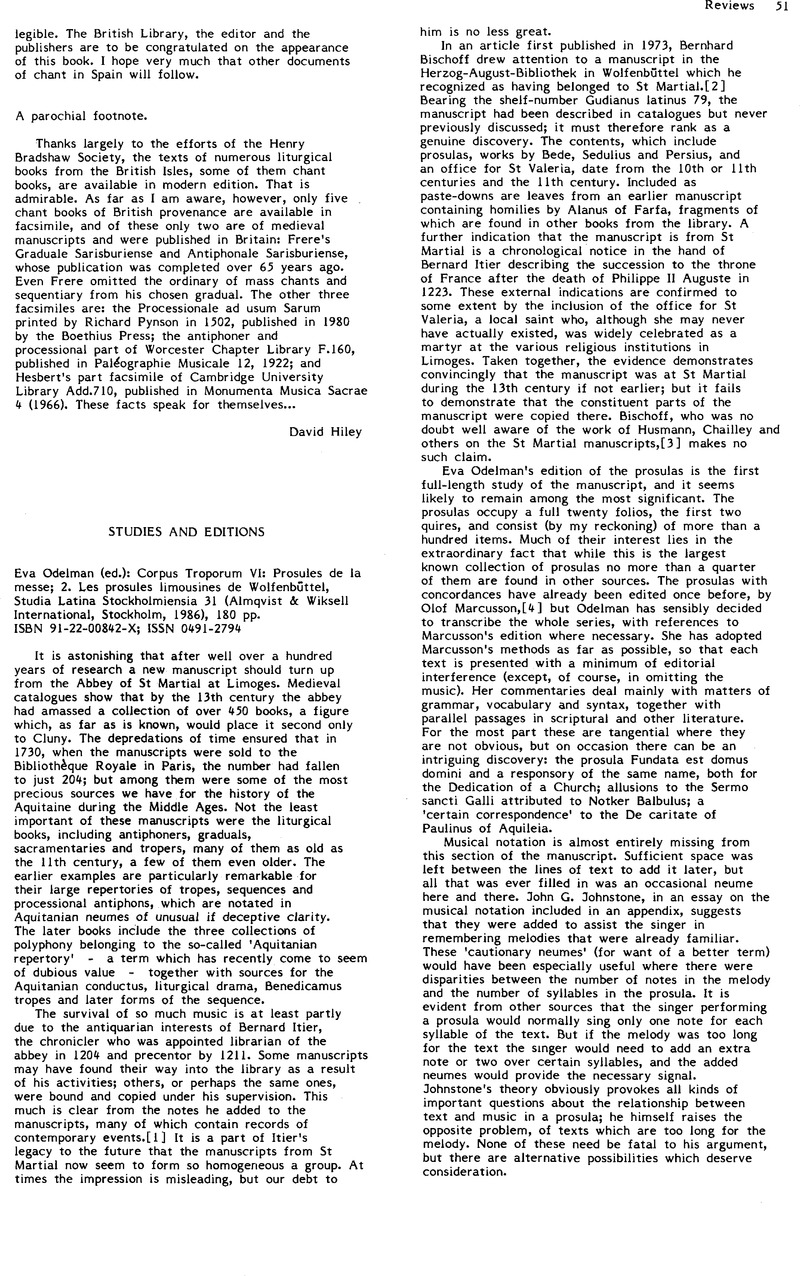No CrossRef data available.
Article contents
Studies and Editions - Eva Odelman (ed.): Corpus Troporum VI: Prosules de la messe; 2. Les prosules limousines de Wolfenbüttel, Studia Latina Stockholmiensia 31 (Almqvist & Wiksell International, Stockholm, 1986), 180 pp. ISBN 91-22-00842-X; ISSN 0491-2794.
Published online by Cambridge University Press: 14 July 2009
Abstract

- Type
- Reviews
- Information
- Copyright
- © The Plainsong and Medieval Music Society 1988
References
Notes
[1] Further notes on Itier can be found in Fuller, Sarah: ‘Itier, Bernardus’, The New Grove Dictionary of Music and Musicians, ed. Sadie, Stanley (London 1980)Google Scholar.
[2] ‘Über mittelalterliche Handschriften in Wolfenbüttel’, Studien, Mittelalterlicher: ausgewählte Aufsätze zur Schriftkunde and Literaturgeschichte, III (Stuttgart 1981), 308; originally published in Wolfenbütteler Beiträge, 2 (1973), 96–109 Google Scholar.
[3] Husmann, Heinrich: Tropen- und Sequenzenhandschriften, Répertoire international des sources musicales, B/V/l (München-Duisburg 1964)Google Scholar; Chailley, Jacques: ‘Les anciens tropaires et séquentiaries de l'école de Saint-Martial’, Études grégoriennes, 2 (1957), 163–188 Google Scholar; idem: L'École musicale de Saint-Martial de Limoges jusqu'à la fin du XIe siècle (Paris 1954); Evans, Paul: The Early Trope Repertory of St Martial de Limoges, Princeton Studies in Music 2 (Princeton 1970)Google Scholar.
[4] Troporum, Corpus II: Prosules de la messe; 1. Tropes de l'alléluia, Studia Latina Stockholmiensia 22 (Stockholm 1976)Google Scholar.
[5] Folio 1 in the manuscript, reproduced as Pl. 1, p. 173 and transcribed on p. 21.
[6] von Heinemann, Otto: Die Handschriften der herzöglichen Bibliothek zu Wolfenbüttel: 4. Die Gudischen Handschriften, Kataloge der Herzog August Bibliothek Wolfenbüttel 10 (Wolfenbüttel 1913), 128fGoogle Scholar. I have taken this reference from Odelman, p. 9, fn. 1, but it seems to conflict with information given by Bischoff in the article quoted above.
[7] Perhaps this is the office described in Emerson, John A.: ‘Two newly-identified offices for Saints Valeria and Austriclinianus by Adémar de Chabannes (Ms Paris, Bibl. Nat., Latin 909, fols. 79–85v)’, Speculum 40 (1965), 31–46 CrossRefGoogle Scholar.
[8] p. 27.
[9] ibid.
[10] Husmann, Handschriften, 136–137; Chailley, ‘Tropaires’, 179. In addition to these, there are some useful comments on the difficulty of establishing the provenance of Aquitanian manuscripts in general in Crocker, Richard: The Early Medieval Sequence (Berkeley 1977), 426–427 Google Scholar.
[11] There are some possible exceptions, including prosulas for St John the Baptist, the Finding of the Cross and Pentecost (pp. 136–138 in the edition) outside the regular order and the apparent omission of Epiphany.
[12] Alleluia-Melodien I: bis 1100, Monumenta monodica medii aevi 7 (Kassel 1968)Google Scholar.
[13] The method is described in Huglo, Michel: ‘Les listes alléluiatiques dans les témoins du graduel grégorien’, Speculum musicae artis: Festgabe für Heinrich Husmann zum 60. Geburtstag, ed. Becker, H. and Gerlach, R. (Munich 1970), 219–227 Google Scholar.
[14] pp. 104–106 in the edition.
[15] Lists of verses are printed in Paléographie musicale XIII: Le codex 903 de la Bibliothèque Nationale de Paris [ed. Beyssac, Gabriel] (Tournai 1925), 42–45 Google Scholar.
[16] Huglo, ‘Listes’, 227.




